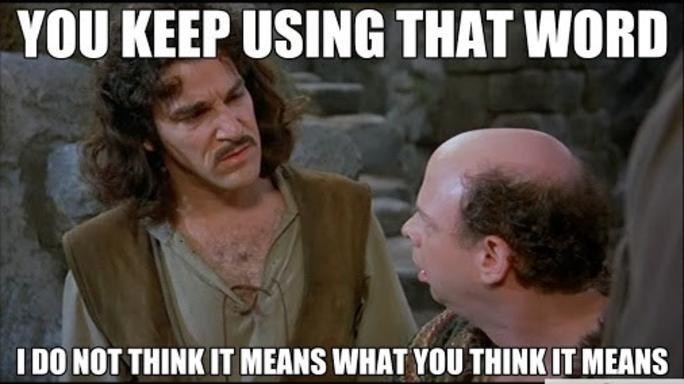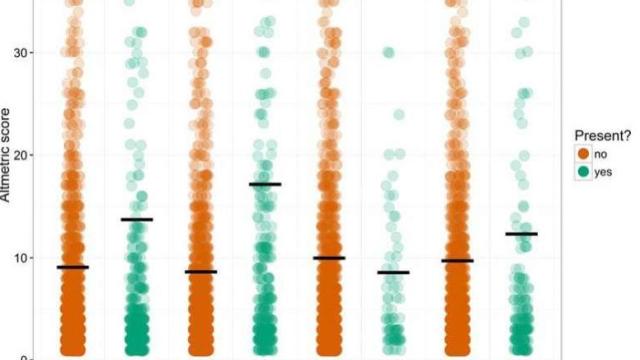Believe it or not, people who write blog posts want you to read their work, and a proven strategy for getting somebody to read something is to give it a snappy title. It seems the same holds true for scholarly papers, at least in the field of psychology.
Academics are just like us: They share papers with catchy titles much more frequently. (Image: MPI for Psycholinguistics)
According to a new paper in the Journal of Psychology, academic papers with titles employing catchier phrasing and positive framing are shared far more widely online compared to those with boring titles. Whether a title is short or long makes little difference — contrary to a 2015 study that found scientific papers with concise titles were much more likely to be cited by colleagues. And including bad puns or other forms of wordplay actually makes a paper less likely to be shared.
“This suggests that academic media is treated similarly to non-academic media by the public in terms of what initially attracts people’s attention,” Gwilym Lockwood, a graduate student at the Max Planck Institute for Psycholinguistics, writes. In other words, academics are no less immune than the rest of us to the allure of click bait-y titles. And since they, too, want attention for their work, Lockwood argues that perhaps they should rely on those same strategies in turn.
Incidentally, Lockwood gets major bonus points for his opening sentence: “You’ll never believe these three amazing clickbait strategies that make people share psychology articles more!”
Let’s take a moment to clarify what we mean by “clickbait”, since it’s a term that gets thrown around a lot these days — usually disparagingly — by people who clearly misunderstand the concept.

The Oxford dictionary technically defines it as content designed to “attract attention and encourage visitors to click on a link to a particular web page”. That’s a woefully inadequate definition. Any kind of title or headline, whether in the New York Times or the National Inquirer, is designed to attract attention and encourage you to engage with the medium by offering a teaser of what’s to come.
The difference is that most publications try to strike a balance between grabbing readers’ attention, and offering them something substantive for their time. True clickbait makes little to no attempt to have the actual content live up to the headline. Lockwood offers a hypothetical example of click bait: An article entitled “OMG the four beauty tips salons don’t want you to know!” that is really just common sense knowledge about eating right, getting your beauty sleep and so on.
As he so eloquently puts it, “Clickbait is the empty calories of the internet, junk food wrapped in glamorous advertising that never quite satisfies but keeps you coming back for more.”
If you read something and think it’s a cool story, it’s not clickbait. It’s a good headline. https://t.co/W58xdmKSL3
— Rachel Feltman (@RachelFeltman) August 16, 2016
Whether it’s clickbait or not, a good headline really matters. A previous study surveying the headlines of articles in the New York Times found readers most frequently shared articles based on two factors: How positive it was, and how emotionally arousing it was. Lockwood set out to determine if the same held true for scholarly articles.
He surveyed the titles of over 2100 papers published in the journal Frontiers in Psychology in 2013 and 2014, and then coded them according to six different factors: “Positive framing”, “phrasing arousal”, word play, titles that contain a question, title length and the social currency of the paper’s topic.
An example of positive framing would be the statement, “smoking causes cancer” versus talking about the “link between smoking and cancer”. An example of phrasing arousal would be referring to “gambling” instead of the far more esoteric “mathematical decision making”.
Then Lockwood corralled a couple of colleagues (both native English speakers) and bribed them with dinner and beer to help him rate each paper on how well they fared in those six categories. Finally, he looked at how all those titles fared on the Altmetric Attention Score, which tracks the mentions of a given article across all media (including social media).
And wouldn’t you know, those papers with the most “clickbait-y” titles fared best in terms of the attention it garnered — although the mean average score of all the papers was a dismal 9.92.
“This research shows that academics can use clickbait strategies to their advantage by framing their findings positively and using more arousing phrasing in their article titles,” Lockwood writes in his conclusion, adding, “Academics should also make their titles shorter, and most importantly, try to make their research actually interesting.” In other words, academics should take a few cues from the media when it comes to grabbing potential readers’ attention.
Academics responded to the news with good humour, even starting up an amusing #clickbaityourpaper hashtag on Twitter:
I ran my model and you’ll never guess what happened next! #clickbaityourpaper https://t.co/DNZDDYwMDr
— Steven J Phipps (@StevenJPhipps) August 18, 2016
Sodium pyrophosphate reveals this silicate’s secret and geotechnical engineers are shocked! #clickbaityourpaper
— Ryan Beemer (@Fuzzy_Reality) August 18, 2016
“9 Unbelievable Ways Publishers Have Slipped Sexism into Your Science Textbooks!” #clickbaityourpaper
— Joanna (Jo) Behrman (@Physhist) August 18, 2016
“Hide your carbon in the ocean using this one WEIRD old trick.” #clickbaityourpaper https://t.co/B1TtmVYkJ6
— Dan Jones (@DanJonesOcean) August 18, 2016
